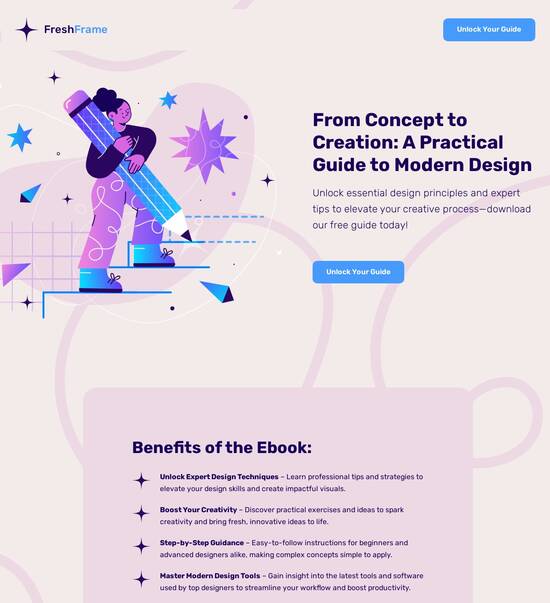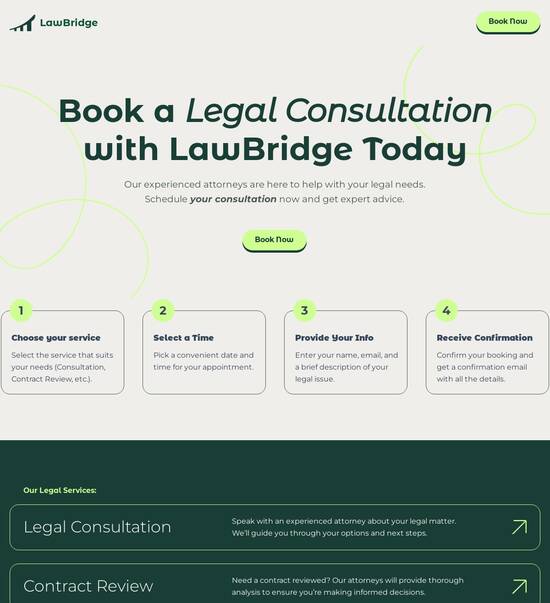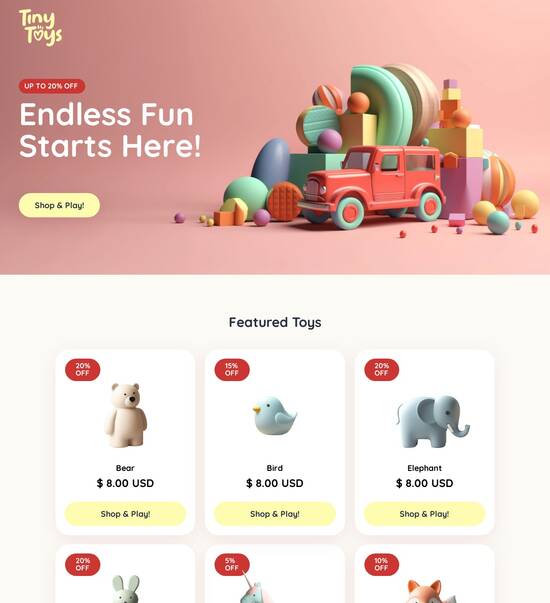
Web page template for bankruptcy law firms
Use TemplateAbout template
Give your bankruptcy law firms a boost with our professional landing page templates. Ready to turn visitors into customers?
Recommended templates

Easy to build without coding
With the intuitive drag-and-drop builder, anyone on your team can create high-converting pages without any knowledge of code or design. Make enhancements to your landing page with custom widgets using Javascript, HTML/CSS, or third-party scripts.

Multiple layouts for any industry and goal
Select from 500+ landing page layouts built to boost conversions across industry-specific scenarios. Customize them by adjusting fonts, adding images, and generating on-brand content with the AI assistant. Quickly scale with Instablocks® and Global Blocks that you can save, reuse, and update globally.

Loads fast and looks polished on any device
Every template is responsive, which means they present professionally on any device and load blazingly fast with our Thor Render Engine. You can also power them up with Google AMP technology to deliver an unparalleled mobile experience and drive higher conversions.

Robust analytics & experimentation
Get real-time updates and reporting across all your devices, showing the number of visitors, conversions, cost-per-visitor, and cost-per-lead. Launch AI-powered experiments, run A/B tests, and use heatmaps to analyze user behavior, then optimize your landing page to maximize conversions.







Easy to build without coding
With the intuitive drag-and-drop builder, anyone on your team can create high-converting pages without any knowledge of code or design. Make enhancements to your landing page with custom widgets using Javascript, HTML/CSS, or third-party scripts.
Multiple layouts for any industry and goal
Select from 500+ landing page layouts built to boost conversions across industry-specific scenarios. Customize them by adjusting fonts, adding images, and generating on-brand content with the AI assistant. Quickly scale with Instablocks® and Global Blocks that you can save, reuse, and update globally.
Loads fast and looks polished on any device
Every template is responsive, which means they present professionally on any device and load blazingly fast with our Thor Render Engine.
Robust analytics & experimentation
Get real-time updates and reporting across all your devices, showing the number of visitors, conversions, cost-per-visitor, and cost-per-lead. Launch AI-powered experiments, run A/B tests, and use heatmaps to analyze user behavior, then optimize your landing page to maximize conversions.
All the features you need to build lead-generating landing pages
Explore more featuresLearn how to build top-performing landing pages for any goal
FAQs
Leading the way in building high-performing landing pages





Maximize your conversions with Instapage: The ultimate guide to creating effective landing pages
Creating compelling landing pages is essential for driving conversions and maximizing your marketing ROI. Instapage stands out as the leading landing page and conversion rate optimization (CRO) platform, designed to equip marketers with robust tools that enhance their campaigns. This step-by-step guide will walk you through the process of leveraging Instapage to create high-converting landing pages tailored to your audience’s needs.
Understand your audience and objectives
To create successful landing pages, identify your target audience within the diverse sectors represented, including education, financial services, and technology. Define clear objectives for your landing pages, such as lead generation or promoting a specific service. Tailoring your messaging to each audience segment significantly boosts engagement and conversion rates.
- Define key demographics: Understand who your potential customers are based on age, location, and interests.
- Set specific campaign goals: Decide on measurable goals, like acquiring leads or boosting attendance for webinars.
- Choose a unique selling proposition: Highlight what makes your offer valuable and different from competitors.
Select a high-converting template
Instapage provides over 100 customizable templates designed for various industries. Start with a template best suited to your campaign goals and industry. Utilize the intuitive drag-and-drop builder to modify elements without needing coding skills. This flexibility enables you to quickly deploy pages tailored to your specific marketing needs.
Optimize landing page elements
To enhance performance, focus on crucial landing page elements such as headlines, images, and calls-to-action (CTAs). Conduct A/B testing to measure which variations drive more conversions. Use Instapage’s built-in analytics dashboard to track user behavior and engagement to inform your optimization efforts.
- Craft compelling headlines: Create headlines that capture attention and clearly convey the offer.
- Use high-quality visuals: Integrate relevant, high-resolution images that resonate with your audience.
- Develop strong CTAs: Make your CTA buttons prominent and action-oriented to guide users toward the next steps.
Personalize user experiences
Target distinct audience segments with tailored content. Instapage offers personalization features, such as dynamic text replacement, to customize landing page content based on user data. Ensure that the imagery and messaging align with the specific characteristics of your audience to improve user experience and increase conversion rates.
- Implement dynamic text replacement: Change keywords or phrases on the landing page based on the user's ad click.
- Utilize AdMaps: Show different versions of landing pages for various advertising sources, enhancing relevancy.
- Track audience-level metrics: Analyze engagement and conversion performance per audience segment to fine-tune your strategy.
By following these structured steps, you can effectively use Instapage to craft landing pages that resonate with your target audience and drive high conversion rates.
Ready to transform your marketing campaigns? Start leveraging Instapage today to create high-converting landing pages that maximize your ROI and optimize your marketing efforts.
Web page template for bankruptcy law firms
Understanding the modern needs of bankruptcy law firms
The digital landscape has transformed how law firms connect with clients, especially in the field of bankruptcy law. Creating a strong online presence has become essential, as clients now prefer to conduct thorough research before approaching legal services. A user-friendly website acts as a starting point for individuals seeking bankruptcy advice, making it imperative for firms to prioritize their digital branding and accessibility.
Client behaviors have shifted significantly, with many potential clients turning to digital solutions for answers to their financial dilemmas. The ability to find critical information quickly can make a significant difference in attracting potential clients. These changing dynamics underscore the need for bankruptcy law firms to invest in effective web design that accommodates these new habits.
Defining the target audience for bankruptcy law websites
Bankruptcy law firms serve a specific demographic facing financial difficulties. Clients typically include individuals overwhelmed with debt, business owners looking to restructure their financial obligations, and even families seeking relief from foreclosure. Understanding who these clients are and what they need is essential in crafting an effective website that speaks directly to their circumstances.
Psychological factors play a crucial role in impacting client decisions, especially for individuals in distressing financial situations. Clients often look for empathy and assurance from their legal representatives. Incorporating design elements that convey understanding and support can foster a sense of trust and connection, guiding potential clients to choose your firm.
Essential components of a successful bankruptcy law firm website
Successful bankruptcy law firm websites share several key features. First and foremost is user-friendly navigation, allowing clients to find vital information effortlessly. A clean and intuitive layout enhances the likelihood that visitors will stay engaged and explore services offered, thus improving the potential of converting them into clients.
Effective Navigation: Clear menus and subcategories that help users find information quickly.
Mobile Responsiveness: Design adaptability for smartphones and tablets to reach clients on the go.
Accessibility: Inclusive design that accommodates users with disabilities.
All these elements contribute to a user experience that not only meets client expectations but also significantly improves overall engagement with the website.
Compelling content strategies for engaging clients
Content is king when it comes to engaging clients on a bankruptcy law firm website. Incorporating multimedia elements such as videos, infographics, and client testimonials can enhance the storytelling aspect and make complex legal concepts more relatable. Visual content often retains attention longer than text alone, making it an essential part of any modern website.
Using clear, straightforward language when discussing legal topics is another imperative strategy. Potential clients are often bewildered by legal jargon; simplifying language helps demystify the bankruptcy process. Structuring content to address common concerns—like the implications of filing, timelines, and rights—can assure clients that they are in the right hands.
Maximizing user engagement through interactive elements
To foster stronger client interaction, websites should integrate dynamic features that streamline the client experience. Booking consultations through an easy-to-navigate interface can significantly reduce barriers for potential clients looking for immediate assistance. Additionally, features such as chatbots or live support can provide instant responses, enhancing user satisfaction.
Online Booking: Simplifying appointment scheduling directly through the website.
Chat Support: Immediate assistance through automated or human-powered chat features.
Resource Libraries: A dedicated section with FAQs and relevant articles empowering clients.
These elements not only enhance user engagement but also position the law firm as a responsive and client-centric practice.
Utilizing data-driven design for optimization
Successful marketing assessment for bankruptcy law firms involves evaluating their website's effectiveness through key performance indicators (KPIs). Metrics such as bounce rates, conversion rates, and average time spent on a website offer insight into client engagement. Regularly monitoring these metrics enables law firms to make informed adjustments that align with client behavior.
Bounce Rate: Percentage of visitors who leave without interacting.
Conversion Rate: How many visitors take desired actions, like filling out a contact form.
Session Duration: Time spent on site, indicating engagement levels.
A/B testing various elements—such as call-to-action buttons, content layout, and design aesthetics—serves to refine user experiences further.
SEO fundamentals tailored for bankruptcy law firms
Search engine optimization (SEO) is crucial for bankruptcy law firms looking to attract organic traffic. Identifying valuable keywords and phrases that potential clients are likely to search is key. Effective content strategies tailored to geographic markets can enhance visibility in competitive spaces. Tactics such as localized content, client reviews, and even partnership with local organizations can boost rankings.
Keyword Optimization: Analyzing and integrating relevant search terms into site content.
Local SEO: Ensuring optimized local listings and search visibility.
Performance Tracking: Monitoring keyword rankings and adjusting strategies as needed.
Implementing sound SEO practices not only attracts new clients but also positions the firm as a key player in the bankruptcy law niche.
The unique aspects of bankruptcy law firm web pages
Bankruptcy law firms need to highlight their specializations effectively, creating a unique value proposition that sets them apart from competitors. Crafting a narrative around the firm's expertise in handling various bankruptcy cases not only builds authority but also instills confidence in potential clients. Helping visitors understand different types of bankruptcies, such as Chapter 7 and Chapter 13, further demystifies the process.
Clear Service Descriptions: Outline the specific bankruptcy services offered.
Expert Articles: Provide informative content that explains legal nuances.
Client Education: Resources designed to empower clients in understanding their options.
The presentation of these components can contribute significantly to a visitor's confidence in entrusting your firm with their legal needs.
Incorporating trust signals to build credibility
In the field of bankruptcy law, establishing credibility is vital. Trust signals like certifications, memberships in legal associations, and visible client testimonials can greatly influence how potential clients perceive your firm. A well-structured case study page that outlines past successes not only serves as a portfolio but also provides social proof that can be highly persuasive.
Visible Certifications: Displaying legal certifications prominently on the website.
Client Testimonials: Featuring positive feedback from past clients to build trust.
Success Stories: Detailed accounts of previously handled cases showcasing expertise.
Using these techniques will contribute positively to the firm’s credibility while helping potential clients feel more secure in their decisions.
The evolution of web design in the legal sector
Web design trends are continuously evolving, and bankruptcy law firms must adapt to these changes to remain competitive. The growing preference for minimalist designs focused on user experience has emerged strongly. Effective use of space, an easy-to-read font, and a limited color palette can lead to a more professional appearance that appeals to clients seeking stability.
Minimalist Designs: Clean layouts that enhance readability and functionality.
User-Centric Features: Elements designed specifically for client ease and engagement.
Visual Hierarchy: Strategically using design to guide visitors to key information.
Staying updated on these trends ensures that bankruptcy law firms present themselves as forward-thinking and adaptable.
Future-proofing law firm websites against technological changes
As technological advancements continue to shape the legal industry, bankruptcy law firms must remain vigilant in future-proofing their websites. Emerging technologies, such as artificial intelligence and augmented reality, offer innovative ways to improve client interaction and service delivery. Exploring and integrating these capabilities when appropriate can set a law firm apart from its competitors.
AI Integration: Chatbots and client assistance tools to streamline interactions.
AR Applications: Enhancing client experiences through engaging visual simulations.
Adaptability: Continually modifying web features to align with user expectations.
Investing in adaptable web design fosters a proactive approach, ensuring that law firms meet both current and future client needs.
Assessing the impact of professional templates
Utilizing pre-designed templates offers multiple benefits for bankruptcy law firms. Templates enhance efficiency by reducing the time and costs associated with web design while maintaining professional aesthetics. Many modern templates also provide customization options, allowing firms to align the site with their unique brand identity and values.
Time Efficiency: Speeding up the design process with ready-made layouts.
Cost-Effectiveness: Reducing expenditures typically associated with custom design.
Customizable Options: Allowing firms to tailor templates to better reflect their branding.
Showcasing case studies from firms that successfully implemented templates offers further evidence of their effectiveness.
Crafting an effective web page template
When designing a web page template for bankruptcy law firms, several key elements must be incorporated. Primary pages include the home page, about page, services page, blog, and contact page. Each of these pages should have a consistent layout, appealing visuals, and clear call-to-action elements to guide visitors toward desired actions.
Home Page: A welcoming overview that outlines services and showcases the firm's value.
About Page: Background information about the firm and its attorneys, promoting transparency.
Services Page: In-depth descriptions of bankruptcy services offered, addressing various client needs.
Blog: Regularly updated legal articles that establish expertise and improve SEO.
Contact Page: A simple form for inquiries and appointment bookings, with contact details.
Including tools for lead capture and engagement optimization enhances the ability to connect with prospective clients.
Guidance on color schemes and typography choices
In the context of legal branding, color schemes can psychologically affect client perceptions. Colors associated with trust and stability, such as blue and green, tend to resonate well in this sector. Selecting a harmonized color palette not only enhances aesthetic appeal but also promotes a positive user experience.
Color Psychology: Understanding the impact colors have on client feelings and perceptions.
Font Selection: Choosing easy-to-read fonts that convey professionalism.
Consistency: Maintaining uniform color and font choices throughout the site for branding.
Implementing these design elements correctly can enhance overall professionalism, ensuring the firm's website aligns with its mission and values.
Strategies for ongoing website improvement
For bankruptcy law firms, it’s vital to pursue continuous learning and adaptation for their websites. Regular updates to content, including insightful legal blog posts, can help keep prospects engaged and enhance search engine optimization through fresh material. Moreover, actively seeking user feedback allows firms to iteratively improve their online offerings and adjust to changing needs.
Content Updates: Regularly publishing and revising content to ensure relevance.
User Feedback: Soliciting and incorporating feedback from visitors to enhance user experience.
Legal News: Keeping clients informed on industry changes that may affect them.
Establishing procedures for improvement creates a dynamic website that evolves alongside client expectations.
Monitoring competitors and industry changes
Monitoring competitors' websites can provide valuable insights for bankruptcy law firms. Analyzing features, content strategies, and overall design elements from competitor sites enables firms to benchmark their operations, discover opportunities for differentiation, and identify gaps in their offerings.
Competitor Analysis: Reviewing competitor websites for features and strengths.
Industry Trends: Staying current on shifts in law and technology that impact services.
Client Preferences: Adjusting website offerings based on observed market demands.
By continually analyzing both competitor websites and industry changes, bankruptcy law firms can position themselves as leaders.
Conclusion of insights
In conclusion, the detailed exploration of web page templates for bankruptcy law firms sheds light on how tailored web design can support not only a strong online presence but also improve client interactions. By implementing effective strategies in web design, content creation, and user engagement, law firms can navigate the complexities of modern legal landscapes and better serve their clientele.
Ready to skyrocket conversions?
Supercharge your ad campaigns with high-performing landing pages
Get started














